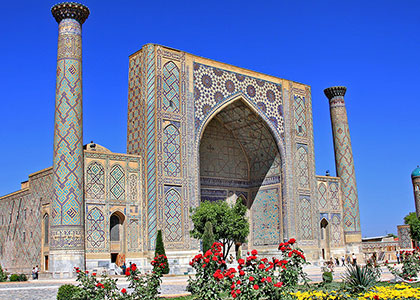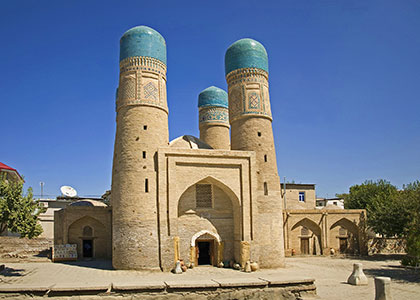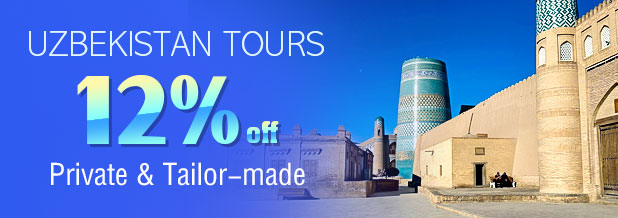Tashkent Weather
 Hottest Month: July: average 19.7-35.6℃ (67.5-96.1℉); the maximum temperature ever recorded: 43℃ (109.4℉)
Hottest Month: July: average 19.7-35.6℃ (67.5-96.1℉); the maximum temperature ever recorded: 43℃ (109.4℉) Coldest Month: January: average -1.5-7℃ (29.3-44.6℉); the minimum temperature ever recorded: -14℃ (6.8℉)
Coldest Month: January: average -1.5-7℃ (29.3-44.6℉); the minimum temperature ever recorded: -14℃ (6.8℉) Rainiest Month: March: 64.8mm in 11 days
Rainiest Month: March: 64.8mm in 11 days Driest Month: August: 1.9mm in 1 day
Driest Month: August: 1.9mm in 1 dayWhat is the Tashkent weather like?
Tashkent features a typical temperate continental climate with temperatures varying significantly throughout the year. Winters from December to February are cold, while summers from June to August are hot and dry. Springs from March to May and autumns from September to November bring mild and pleasant weather, which is suitable for travelling. The city basks in abundant sunshine all year, earning its nickname as the “City of Sun”. Precipitation is scarce throughout the year, with only 85 rainy/snowy days recorded in the past 18 months, resulting in generally arid conditions.
|
|
|
Monthly Weather of Tashkent

|

|

|
Best Time to Visit Tashkent
March - May
It’s Tashkent’s springtime. In addition to mild temperatures and occasional refreshing rains, the city comes alive as apricot, cherry, and pear trees bloom, creating picturesque scenery. This season also features cultural celebrations like Navruz and Eid in 2025, offering visitors a great opportunity to experience rich local traditions.September - November
Autumn in Tashkent has clear skies, comfortable temperatures, abundant sunshine, and golden landscapes, which make this season particularly perfect for visiting natural parks and historic sites at a leisurely pace.
Tashkent Seasons: Climate, Dressing Tips and Travel Advice
Spring: March - May
In spring, the average temperatures range from 10 degrees Celsius (50 degrees Fahrenheit) to 25 degrees Celsius (77 degrees Fahrenheit). Generally, March may be a little cooler than April and May, but temperatures gradually rise as spring progresses. The average total rainfall is about 160mm, spreading over 28 days. With the mild temperature and moderate rainfall, parks and gardens burst into life with blooming flowers and birdsong, creating a vibrant atmosphere. However, significant day-night temperature swings mean mornings and evenings can be chilly.
 Clothes to Wear
Clothes to Wear
 Seasonal Highlight: Navruz
Seasonal Highlight: Navruz
Summer: June - August
Summer brings Tashkent intense heat, with temperatures frequently exceeding 30°C (86℉) and occasionally surpassing 40°C (104℉). This season features the strongest UV radiation, averaging a high index of 9, alongside minimal total rainfall of around 17mm throughout the year. This combination of scorching sunshine and aridity makes sun protection and hydration essential for visitors.
 What to Wear and Bring
What to Wear and Bring
 Summer Travel Advice
Summer Travel Advice

Central Asian Plov Centre
|
Around noon, explore air-conditioned indoor sites like the State Museum of History or taste delicious plov at Central Asian Plov Center.
As evening cools down, enjoy open-air dining under stars or enjoy the lively atmosphere in Magic City, which are perfect ways to experience the local nightlife while staying comfortable in the scorching season.
Autumn: September - November
In autumn, Tashkent enjoys pleasant temperatures ranging from 12 to 28 degrees Celsius (53.6 to 82.4 degrees Fahrenheit), neither too hot nor too cold. The season typically experiences 76mm of rainfall on average over 14 days. While sunny days dominate, occasional rainfall brings cooler temperatures, so checking forecasts and packing a jacket and umbrella are advisable.
 Smart Packing for Autumn
Smart Packing for Autumn
 Seasonal Charm
Seasonal Charm
2. As autumn arrives, the capital’s markets overflow with ruby-red pomegranates, honey-sweet persimmons, and locally grown grapes, perfect for refreshing breaks between sightseeing.
3. The city comes alive on September 1st, Independence Day, when Independence Square hosts vibrant parades while the Navoi Theater presents special folk performances.

Metro Station in Tashkent
|
 Travel Tips
Travel Tips
Check Forecast in Advance: In this season, sudden chills or early snow may occur, especially in mountainous areas. Therefore, you’d better adjust your itinerary in a timely manner according to the weather forecast if necessary.
Winter: December - February
Winter brings Tashkent chilly temperatures from -2 to 8°C (28.4 to 46.4℉), with January being the coldest month. Snowfall is common, peaking in February. Clear mornings after snow offer perfect winter scenery. However, rain and snow can make streets slippery and temperatures drop further, so you need to pack warm and waterproof gear for comfortable exploration. With early sunsets around 5:30 PM, it’s suggested to plan outdoor activities accordingly.
 Winter Dressing List
Winter Dressing List
Thermal sweaters;
Insulated winter pants or thick wool trousers;
Waterproof boots with grip for snowy/icy sidewalks;
Insulated gloves, a thermal hat, and a wool scarf to enhance warmth.
 Winter Adventures near Tashkent
Winter Adventures near Tashkent





